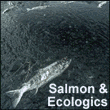In what has become an annual exercise, the Technical Management Team reviewed hydroelectric operations it had directed to protect salmon and other species, as well as fish migration results, at its Nov. 6 meeting.
Each year at this time TMT takes extra time to reflect on the decisions it made in the previous 12 months and to look at some of the results. For the past two years, reviews had included discussions about drought, low water and lack of spill. But with average water and big returns of adult salmon the past 12 months, the discussion was generally more reflective, lacking accusations heard in past years.
Here's a synopsis of the review:
- Snake River flow augmentation -- Tony Norris, Bureau of Reclamation, said that only 288,800 acre feet of water was delivered this year from the upper Snake River basin, not the 427 kaf that in previous years has been required by NOAA Fisheries. BOR provided 116.4 kaf to Idaho Power's Brownlee reservoir, which the company did move downstream, Norris said. The utility also added 25 kaf to that total. "We chase after kaf," Norris said. "If we can find, we buy it," often at a cost of about $50 per acre-foot.
- Total dissolved gas -- Laura Hamilton, U.S. Army Corps of Engineers, said that operations at Corps dams exceeded total dissolved gas limits more often this year -- 82.3 percent of the time -- than in previous years. She said that was largely due to conditions outside the Corps' control. Jim Ruff of NOAA Fisheries added that testing of new spillway deflectors and spill patterns, along with a condition beyond control below Bonneville Dam caused by winds and sun that increased gas levels are some of the causes for the exceedences. Ron Boyce, Oregon Department of Fish and Wildlife, said there were some instances where spill levels were not met.
- Fall Chinook Survival in the Snake River -- Billy Connor, Idaho Department of Fish and Game, said that his study shows that summer flow augmentation (June 21 through Aug. 31) and lowering water temperature increases juvenile fall chinook survival in the Snake River down to Lower Granite Dam. Spring flow augmentation benefits are less certain, although it may improve seaward movement of the juveniles, he said, referring to studies by other biologists. Conners has been studying juvenile fall chinook migration in the Snake River since 1992.
- Hanford Reach Juvenile Stranding -- Fewer emerging fall chinook salmon were stranded on Hanford Reach this spring than in past years, according to Paul Hoffarth of the Washington Department of Fish and Wildlife, and most of the limited stranding occurred early in the emergence season when fry were smaller. Hoffarth said that the juveniles are less susceptible to stranding the larger they are, especially after they grow to 60 millimeters or larger. "I think where we're at right now is to just to fine-tune the operations," Hoffarth said of successful operations during this spring. Currently, the Reach is experiencing the second highest adult return in history, with a projected total of about 80,000 adults, he said. The Vernita Bar agreement governs hydroelectric operations at Grant County Public Utility District's Priest Rapids Dam upstream of Hanford Reach for both spawning and emerging fall chinook. The adult operation ends Nov. 24.
- Juvenile survival -- Estimates of the percentage of juveniles that survived the gauntlet of dams from Lower Granite Dam through Bonneville Dam increased this year after the low survival rates of 2001, according to Paul Wagner, NOAA Fisheries. The BiOp standard for fall chinook survival is 49.6 percent. 2001 survival fell to 27.6 percent, while 2002 survival rose above the standard to 52.9 percent. Steelhead faired worse, however. The standard is 51.6 percent, but 2002 survival was only 30 percent, still far better than 2001 when survival of steelhead was estimated at 4 percent. Wagner said the problem area is the reach between McNary Dam on the Columbia River and Lower Monumental Dam on the Snake River where there is growing colony of Caspian terns. Steelhead are especially hard hit by the terns because they are larger targets, Wagner said. The numbers refer to fish that remained in the river. In 2001, 95 percent of fish were barged.
- Fish Migration -- Chris Ross of NOAA Fisheries said there was a prolonged migration of juvenile salmon and steelhead and their migration responded quickly to peaks in flows.
- Weather report -- Kyle Martin of the Columbia River Intertribal Fish Commission said that the return to normal precipitation in 2002 signaled the end of the drought. He forecasts near-normal weather in 2003.
Related Sites:
Technical Management Team
CBB Staff
River Managers Review Past Year's Operations
Columbia Basin Bulletin, November 15, 2002
See what you can learn
learn more on topics covered in the film
see the video
read the script
learn the songs
discussion forum



